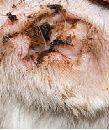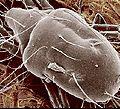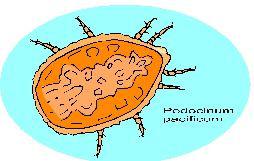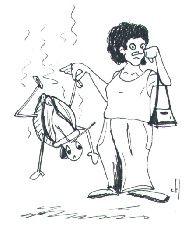Natural Solutions to Things That Bug You (30 page)
Read Natural Solutions to Things That Bug You Online
Authors: Myles Bader


General Information:
Ear mites are a tiny spider like parasitic mite that infects the ears of dogs and cats. They usually live in the ear canals but may also live on other parts of the dog or cat's body. Ear mites are the most common cause of ear infections found more frequently in cats than dogs but are a considerable cause of ear infection in dogs as well.
Certain breeds of dogs are more prone to ear mite infections that others, especially dogs with long floppy ears. The ear mites live comfortably in the warm moist area where the air flow is restricted. They feed on dead skin debris & ear wax and burrow into the ear, causing inflammation which if you have a look inside the ear of an infected dog you will see dark reddish brown or black debris throughout the ear canal looking like coffee grounds.
Ear mites are actually visible to the naked eye and can be seen as white spots among the dark debris. You may even spot them moving around.
Ear mite infections are serious if left untreated and can result in damage to the ear canals and eardrums and possible deafness.
Ear mites are uncomfortable for your cat or dog having thousands of little bugs running around in one of their most sensitive areas. The first symptom you notice will be your dog scratching his ears or shaking his head due to the extreme itchiness. Dogs may cause damage by scratching causing the ears to bleed and even shake their ears with such intensity that small blood vessels are broken.
OIL THEM
Place a few drops of olive oil on a cotton ball and place it in the ear for a minute or two, then be sure and remove all traces of the oil.
GRAIN MITES
Grain mites are not really insects, but are closely related to insects. They are microscopic, pale grayish white, wingless and soft bodied. Their populations can increase to such a large number that grain appears to be covered with a moving layer of dust. Adults have 8 legs, while larvae only have 6 legs and each leg has one claw on the end along with a sucker.
 They will attack not only grain but cheese, flour, pet food, oilseeds, medicinal herbs, hay, abandoned beehives and just about any food used by man. Grain mites can even feed on fungi so food that is going bad is often infested. In grain, mites eat the germ and only eat the endosperm if it is moldy.
They will attack not only grain but cheese, flour, pet food, oilseeds, medicinal herbs, hay, abandoned beehives and just about any food used by man. Grain mites can even feed on fungi so food that is going bad is often infested. In grain, mites eat the germ and only eat the endosperm if it is moldy.
Populations of grain mites are sensitive to moisture conditions and if the grain moisture drops to below 13.4%, all individuals will die. Environmental conditions are perfect for extreme population growth at temperatures between 20 and 25˚C (68 to 77˚F). Development time for one generation ranges from 78 days at 4˚C (39˚F) to 9.2 days at 28˚C (82˚F). Their life span depends upon temperature, food, and reproductive activity. Females under ideal conditions live 42-63 days. Male survivorship is usually only a few days less.
Grain mite populations can explode when they feed on wheat germ, yeast, cheese, powdered milk, flour, or grain. In finely ground commodities such as flour and powdered milk, infestations are confined to the surface layer while whole or cracked grains and nuts may be totally infested.
THE GROCER’S ITCH
Since there are so many mites around, especially in foods, there are two, mite infestations that have been related to people that work with grains. The grocer’s itch and the baker’s itch are commonly found in markets and bakeries. It is best to keep humidity out of your grains.

HOT CHILI TO THE RESCUE
If you place a very hot chili pepper in the grain you will not have any insects residing there. The hotter the better but be sure that it is a whole pepper with no externally visible damage or you will ruin the taste of the grain.
MOLD MITE
LOVES HUMIDITY
 The mold mites will invade almost any food, especially grains and breads if the humidity is relatively high. The drier the products are kept the better. If you have this problem in your area it would be wise to store grain and grain-related products in the refrigerator or freezer. They are harmless to people and pets.
The mold mites will invade almost any food, especially grains and breads if the humidity is relatively high. The drier the products are kept the better. If you have this problem in your area it would be wise to store grain and grain-related products in the refrigerator or freezer. They are harmless to people and pets.
Mold mites are part of a large group of similar species that are hard to tell apart. Similar members in this group of tiny mites include the cheese mite, flour mite, and grain mite. Mold mites are very common but usually go unnoticed except when they become abundant. They infest stored food and grain and can cause big losses although they are more usually an annoyance and nuisance and not injurious.
They are harmless to people and pets, furniture, house structures and clothing. Mold mites only develop where there is adequate moisture or high humidity. They feed on molds and are common only where mold and fungi can flourish.
Control of mold mites is difficult and is likely to require persistence. The first step should be to eliminate humidity or moisture that is producing favorable conditions for molds and mites.

STINKBUG

These are flat green, shield-shaped bug that will cause tomato plants to develop white spots as they suck out the juices. If they are not causing a problem these may be beneficial since they will act as a parasite and kill pest caterpillars and beetles. They will lay a cluster of brown or green eggs on the underneath side of leaves.
PARASITE TO KILL A PARASITE
The parasite that will eliminate the stinkbug is called
Trissolcus basilis.
You can also hand pick the stinkbugs and their eggs off your plants.
SPRAYS WORK WELL
A soap spray using 4 drops of liquid soap and ¼ cup of lime in 1 gallon of water will take care of the problem.
THRIPS
Identification:
 These are very small (almost invisible) yellow or black insects that attack plants and flowers and suck out their juices as well as spreading many plant diseases. Under a magnifying glass they will look like long, elongated bugs that have a double wing with fancy fringe. They can range in color from yellow to almost black.
These are very small (almost invisible) yellow or black insects that attack plants and flowers and suck out their juices as well as spreading many plant diseases. Under a magnifying glass they will look like long, elongated bugs that have a double wing with fancy fringe. They can range in color from yellow to almost black.
